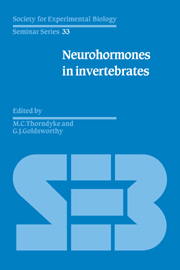Book contents
- Frontmatter
- Contents
- List of contributors
- Preface
- What is special about peptides as neuronal messengers?
- Part I Immunocytochemistry and Ultrastructure
- Part II Arthropod Neurohormones
- Characterization of insect neuropeptides
- The isolation and characterisation of vertebrate-type peptides in insects
- Humoral functions of insect neuropeptides
- Functions of aminergic and peptidergic skeletal motoneurones in insects
- Physiology and biochemistry of crustacean neurohormonal peptides
- Part III Neurohormones in Coelenterates, Annelids and Protochordates
- Part IV Neurohormones in Molluscs
- Index
Humoral functions of insect neuropeptides
Published online by Cambridge University Press: 04 August 2010
- Frontmatter
- Contents
- List of contributors
- Preface
- What is special about peptides as neuronal messengers?
- Part I Immunocytochemistry and Ultrastructure
- Part II Arthropod Neurohormones
- Characterization of insect neuropeptides
- The isolation and characterisation of vertebrate-type peptides in insects
- Humoral functions of insect neuropeptides
- Functions of aminergic and peptidergic skeletal motoneurones in insects
- Physiology and biochemistry of crustacean neurohormonal peptides
- Part III Neurohormones in Coelenterates, Annelids and Protochordates
- Part IV Neurohormones in Molluscs
- Index
Summary
Introduction: Hormones and development
Since Kopec's demonstration of a humoral role of the brain in insect development, peptide hormones have had a central historic importance in the study of insect endocrinology: the brain produces prothoracicotropic hormones (PTTH's; see Bollenbacher & Granger 1985), thus stimulating moulting by initiating ecdysone synthesis and release by the prothoracic glands. A second neuropeptide, eclosion hormone (see Reynolds & Truman 1983), initiates the necessary behaviour patterns associated with ecdysis and its timing. Subsequently, a third neuropeptide, bursicon (see Reynolds 1983; 1985), controls the tanning of the new cuticle and stimulates endocuticle deposition. Neuropeptides are also implicated in the control of corpus allatum activity; both allatohibins and allatotropins being identified in various insects (see Tobe & Stay 1985). Unfortunately, chemical characterisation of these peptides has progressed slowly. The physiological actions of most of these peptides concerned with development have been the subject of numerous and extensive reviews (see for example Downer & Laufer 1983; Kerkut & Gilbert 1985) and will not be dealt with here.
Recently considerable progress has been made in the characterisation of PTTH's from Bombyx mori (Nagasawa et al. 1984, 1986). Characterisation of these polypeptides has been hampered by their heterogeneity (in several species high and low molecular weight forms exist) but also, no doubt, due to the impurity of the starting material used. The sequence of 4K-PTTH-II one of the small Bombyx hormones, has now been determined (Nagasawa et al. 1986).
- Type
- Chapter
- Information
- Neurohormones in Invertebrates , pp. 141 - 158Publisher: Cambridge University PressPrint publication year: 1988
- 9
- Cited by



